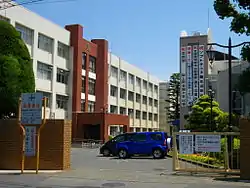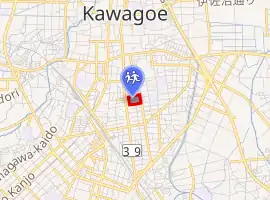Kawagoe Technical High School
Kawagoe Technical High School (Japanese: 埼玉県立川越工業高等学校, Hepburn: Saitama-kenritsu Kawagoe Kōgyō Kōtōgakkō, lit. Saitama Prefectural Kawagoe Industrial High School) is a public co-educational senior high school located in Kawagoe City, Saitama Prefecture, Japan. The high school was founded as the Kawagoe Dyeing and Weaving School (埼玉県立川越染織学校, Saitama-kenritsu Kawagoe Senshoku Gakkō) in 1908 by the Saitama prefectural government.
| Kawagoe Technical High School 埼玉県立川越工業高等学校 | |
|---|---|
 | |
| Location | |

| |
350-0035 Japan | |
| Coordinates | 35°54′47″N 139°29′13″E |
| Information | |
| Type | Public |
| Motto | Fidelity (誠実, Seijitsu), Diligence (勤勉, Kinben), Ingenuity (創意, Sōi) |
| Established | 29 April 1908 |
| Founder | Saitama prefectural government |
| Gender | co-educational |
| Website | www |
The school is the oldest high school in Saitama Prefecture and has both full-day and part-time courses. Its alumni include the "Father of the Walkman", former President of Sony China Shizuo Takashino. In 2015 students of the school set a Guinness World Record for the "longest distance traveled by a vehicle on a railway track powered by dry cell batteries".
History
Establishment of the Kawagoe Dyeing and Weaving School (埼玉県立川越染織学校, Saitama-kenritsu Kawagoe Senshoku Gakkō) was approved on 7 May 1907 and the initial course was a three-year "upper-primary" (ja:高等小学校, kōtō shōgakkō) for children aged 12 to 15 years old. The school officially opened on 29 April 1908 with capacity for 100 students in its dyeing and weaving course.[1] A design course was subsequently added in 1912.
In April 1918 the school's name was changed to Saitama Prefectural Technical School (埼玉県立工業高等学校, Saitama-kenritsu Kōgyō Gakkō). A two-year preparatory course was established in April 1919 with capacity for 80 students, however it was abolished in 1921. A the same time, the regular courses became five years in length and an elective course was established.[1]
The school's name was changed to Saitama Prefectural Kawagoe Technical School (埼玉県立工業高等学校, Saitama-kenritsu Kōgyō Gakkō) on 1 April 1937. Applied chemistry and architecture courses were added in 1941 and 1942 respectively, increasing the school's total enrolment to 470. The school's current name was adopted in April 1948.[1]
In April 1987 the textile engineering course was renamed as the textile design course and became coeducational. In April 1991 the industrial chemistry, architecture, mechanical and electrical courses also became coeducational.[1]
On 3 November 2015 students from the school, in collaboration with Panasonic, set a Guinness World Record for the "longest distance traveled by a vehicle on a railway track powered by dry cell batteries". A train weighing more than one ton was powered by 600 dry cell batteries and travelled a distance of 22.6 km along the Chokaisanroku Line in Akita Prefecture.[2]
Notable alumni
- Seijuro Arafune – politician and former Minister of Transport
- Makoto Hirayama – politician in the national Diet
- Masahiko Ishida – former professional baseball pitcher for the Chiba Lotte Marines
- Hidenori Kosaka – former professional baseball pitcher for the Yomiuri Giants
- Sakan Morita – former professional baseball pitcher for the Taiyo Whales
- Masahiro Nojima – former baseball infielder who represented Japan at the 1996 Summer Olympics
- Takeshi Sato – former professional baseball pitcher for the Hiroshima Carp and Yakult Swallows
- Akio Shiibashi – developer of the Suica IC card used by the East Japan Railway Company[3]
- Shizuo Takashino – Sony executive known as the "Father of the Walkman[3][4]
- Keiichi Tanaka – mayor of Warabi, Saitama from 1975 until 2007
References
- "沿革" [History] (in Japanese). Kawagoe Technical High School. 2010. Retrieved 5 February 2016.
- "Longest distance traveled by a vehicle on a railway track powered by dry cell batteries". Retrieved 5 February 2016.
- "100周年記念" [Centenary Memorial] (in Japanese). 2008. Retrieved 5 February 2016.
- ""ウォークマンの父"がソニー中国トップに就任" ["Father of the Walkman" appointed head of Sony China] (in Japanese). Nikkei Business Publications. 28 April 2006. Retrieved 5 February 2016.